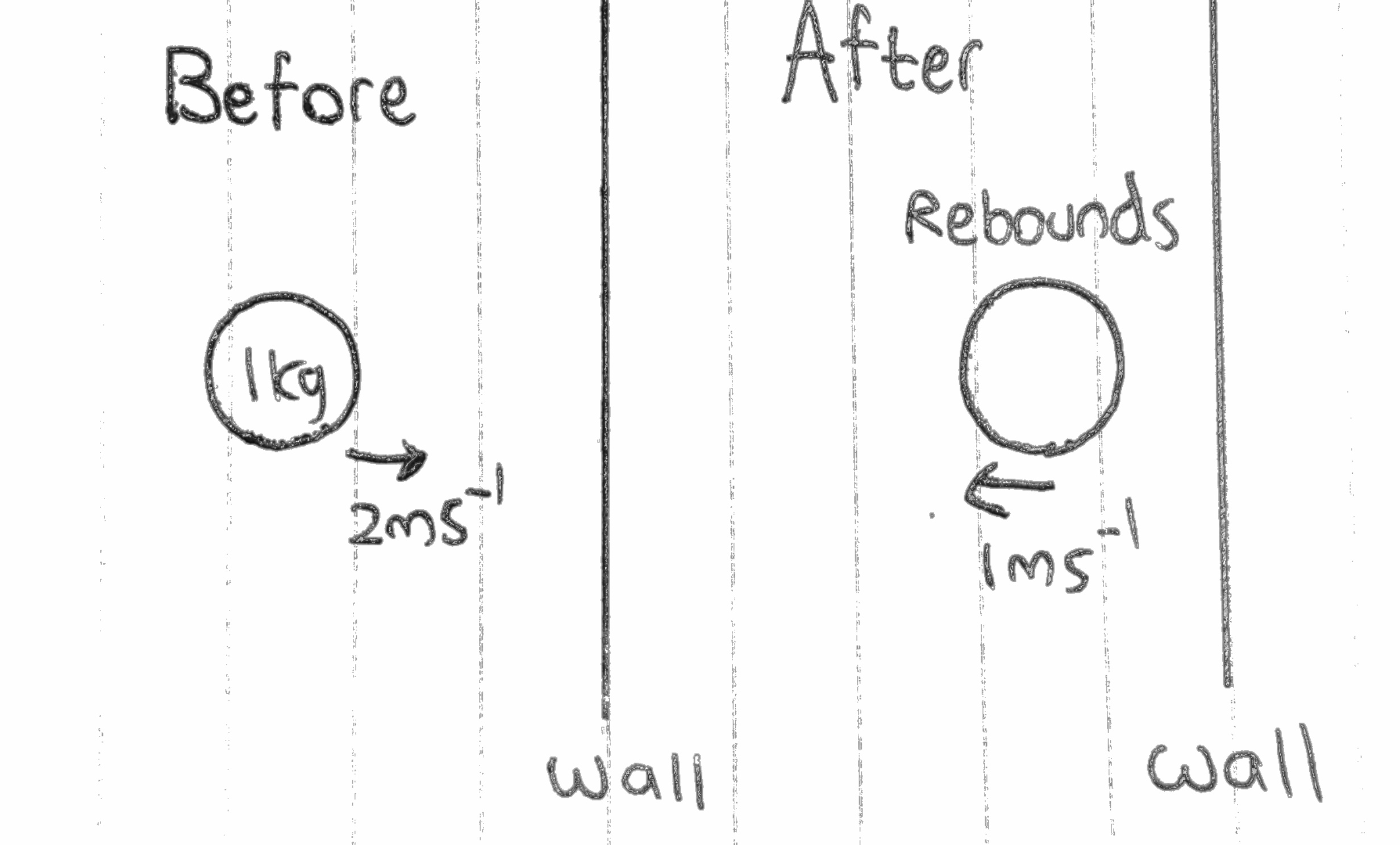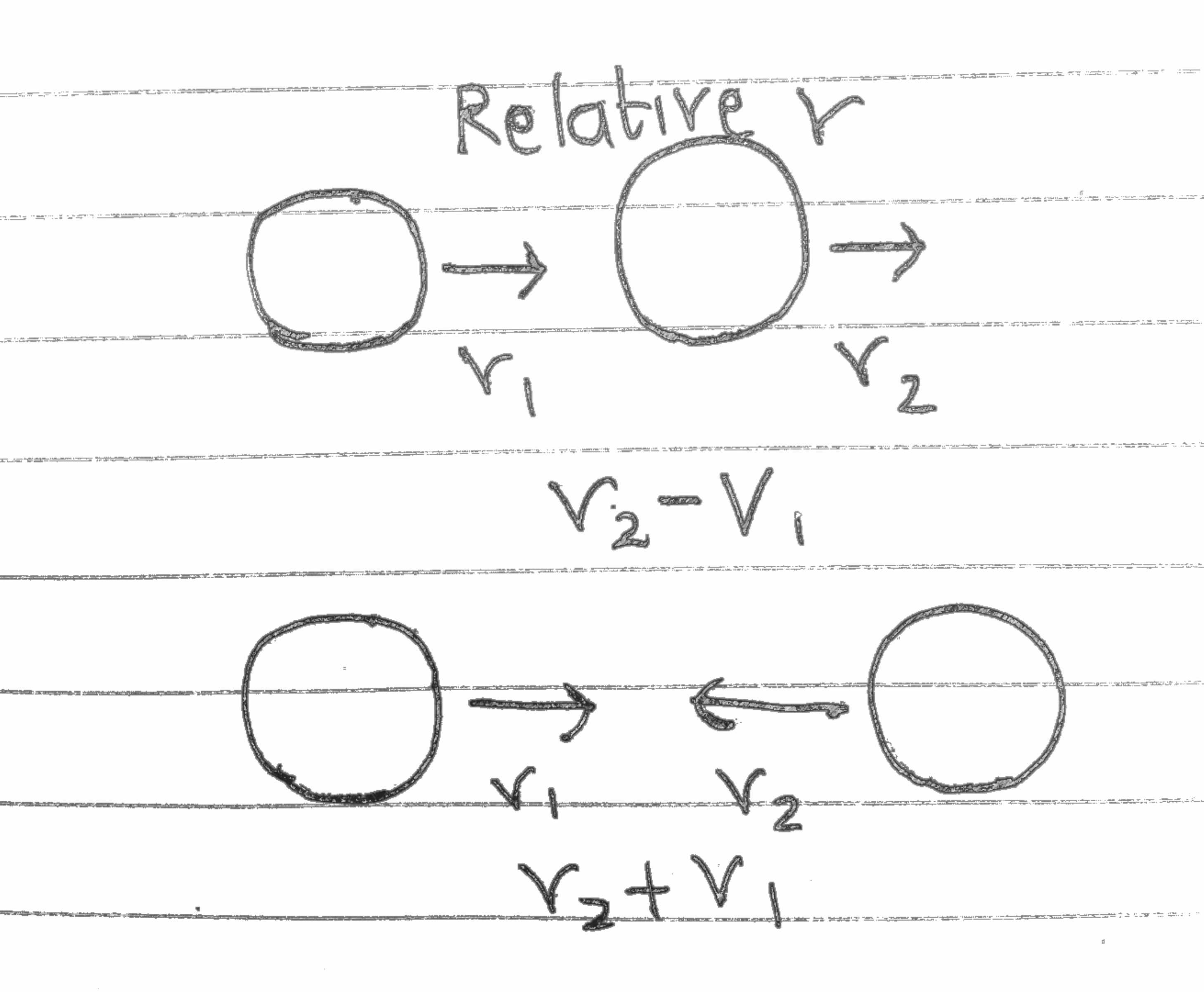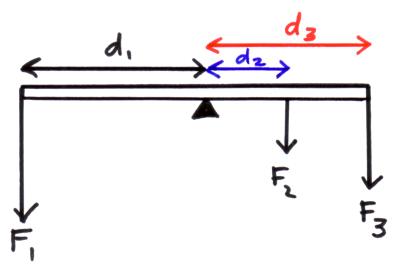Physics AS
Introduction Physical Quantities & Base units Vectors & Scalars Kinematics Pressure & Density Dynamics Momentum Energy, power & efficiency Deformation of solids Waves Superposition Stationary waves Electric fields Electricity Circuits & Kirchoff's laws Radioactive Physics AS PracticalPaper 5More
Reference Pastpaper QuestionsMomentum, Moment & Torque
What is Momentum?
It is Mass times Velocity
SI units : Kgms-1
Momentum = mass * velocity
p = mv
Momentum is a vector and so direction/sign must be considered
How to find the total momentum in a system
For the example below, both objects are moving in the opposite direction with the same speed. So one object has a positive velocity and the other one has a negative velocity
So when calculating momentum for each object, the sign of the velocity must be considered

Momentum of object 1 = 1kg * 0.5ms-1
Momentum of object 1 = 1kg * -0.5ms-1
Notice that one velocity is negative as it's moving in the opposite direction
To find the total momentum we just need to add both of them .
0.5 + (- 0.5) = 0
So really the sum is zero
How to calculate the change in momentum
Usually this refers to only one object

Change is the opposite of Sum
Change in momentum = Final momentum - initial Momentum
Change in Momentum = mv - mu
This is only for one object
For example a mass of 1kg moving at 2ms-1 rebounds with a velocity of 1ms-1
Calculating the change in momentum
(1*2)-(-1*1) = 3kgms-1
What if the object rebounds and changes direction
This can be applied for the above example.
As there is now a change in direction, the final Momentum is negative. This is because, the sign of the velocity is also negative(opposite)
So we just add it, why?
Change in momentum = -mv - mu
So now it's more negative so the change is in the opposite direction and greater in magnitude. However, "change" does not usually include the sign.
The sign is very important as it shows the BALL experiences a force in the opposite direction - this means for the change of momentum to be negative a resultant force must be in the opposite direction
And the ball exerts an equal and opposite force on the wall when rebounding
We already know the definition of force
Force = Rate of change in momentum
Force = (mv - mu)/t
Another word for change in momentum is Impulse and it is same as:
Impulse = Force * time
Force * time = mv-mu
Just remember it like a push. When someone keeps pushing you for some time. Greater the push(force) and time. The more you fall!
Law of conservation of momentum
In closed system where there is no external forces acting, the total momentum before and after the collision is the same
So we can calculate the sum of the momentum of a system by adding the momentums together(considering the signs also)
This sum should then equal to the momentum after the collision
That's why we found, how to calculate the total momentum of a system
The proof or reason
This is actually important so remember this!
As when both objects collide, object A experiences an equal but, opposite force from object B and vice versa (Newton's 3rd law) for the same collision time. So the impulse or the change in momentum is the same and so momentum is conserved.
We apply this law when making sure that the total momentum before and after the collision is the same
Elastic and inelastic collisions
So we need to distinguish the difference between an elastic and inelastic collision:
- Elastic collision
- Inelastic
- If they say both share the same velocity, it means they are stuck together and the momentum is shared across the combined mass. This is always an inelastic collision
- Also momentum is always conserved and so is total energy of the system. Kinetic energy may not be conserved
- Same magnitude
- Opposite direction
- Acting on different objects
- Same line of action of force/ So no torque
- Same type of force
- Same magnitude of force
- Parrel and opposite
- They are separated by a perpendicular distance of s or d
The kinetic energy before and after the collision is the same
There is an easier way to identify an elastic collision
The relative speed of approach is equal to the relative speed of seperation
To calculate relative speed, you should use a bit of logic. When two objects are moving in the same direction, then the relative speed is the difference. If they are moving in opposite direction, the relative speed is the sum of two velocities.

Remember that K.E is a scalar and so we just take the magnitude of the K.E of an object(excluding any signs)
It's when kinetic energy before and after the collison are not the same. Energy is transformed to other forms of energy
Important points:
Newton's 3rd Law of motion
As we discus what it is, we will see how to identify the pairs
For example below, the gravitational force between planents are of the same type ,same magnitude and etc. Always remember the features above
Moment and torque
They are very similar things however, applied in different situations
Moment
The product of force and the perpendicular distance from the pivot to the line of action of the force
Moment = Force * Perpendicular distance from the pivot..
You must always sayperpendicular!
So you can either find the component of the force which is perpendicular to the distance (resolving), which is the easiest way - we followed the same method in energy but, in this the force must be perpendicular

Remember that moment is actually a vector and it has a direction - clockwise or anticlockwise
Principle of Moment
When in equilibrium, the sum of anticlockwise moment of a point is equal to the sum of clockwise moment of the same point. So no net moment

Like the above one -
The clockwise moment:
F2d2+F3d3= Momentclockwise
The anticlockwise moment:
F1d1= Momentanticlockwise
As we know that the clockwise and anticlockwise momentum is equal we can:
F1d1 = F2d2+F3d3
So we can find the missing forces or missing distances
This can be used to do questions which state that the system is in equilibrium but, let's first see what center of gravity means!
Center of gravity
The imaginary point where weight is considered to act on
Center of mass
The geometrical center of an object
The imaginary point where weight is considered to act on
Center of mass
The geometrical center of an object
Center of mass and gravity are two different things but, can be the same if the object is uniform and the same material all the way. This is used in gravitational fields(point masses)
So usually the center of gravity is the point where the weight of the beam is considered to act on
So you need to remember that the weight of the beam can be represented by a resultant force and this also must be considered in moment calculations
Torque
It is the product of one of the forces and the distance between the two oppsite but, parallel forces
Torque = Force*distance between the couple
What is a couple?
The two forces acting opposite to each other is called a couple
They have these characteristics:
So torque only gives turning effect, where as moment can give linear acceleration unless it's stopped by a pivot

The resultant force in a torque is zero but, not in equilibrium as it has a net moment or torque
Recommended
These are things you might like. Clicking these ads can help us improve our free services in the future...
End of Chapter Videos
Collection of Videos to Support Your Understanding.
Remember these videos are handpicked by me and I feel these are the best ones out there. But I constantly update this list for each chapter. The Youtubers are more than welcome to contact me.
Also, don't forget to Subscribe to our Youtube channel - MrWik
Watch
